Why you can trust Tom's Hardware
To read about our monitor tests in-depth, please check out Display Testing Explained: How We Test PC Monitors. We cover brightness and contrast testing on page two.
Uncalibrated – Maximum Backlight Level
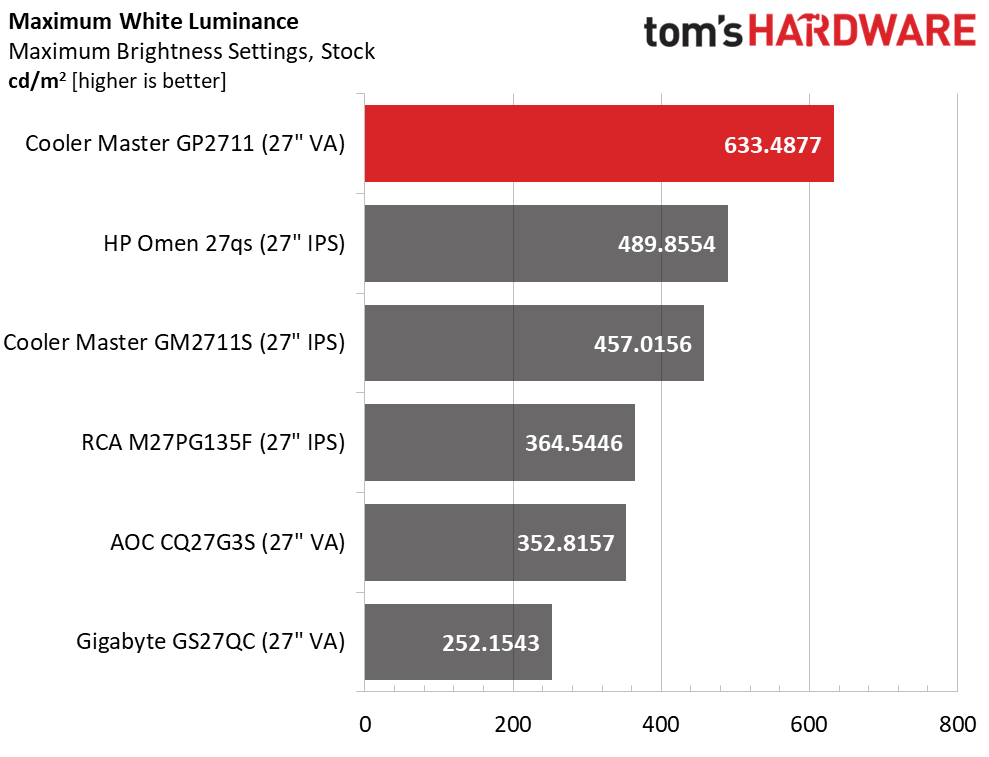
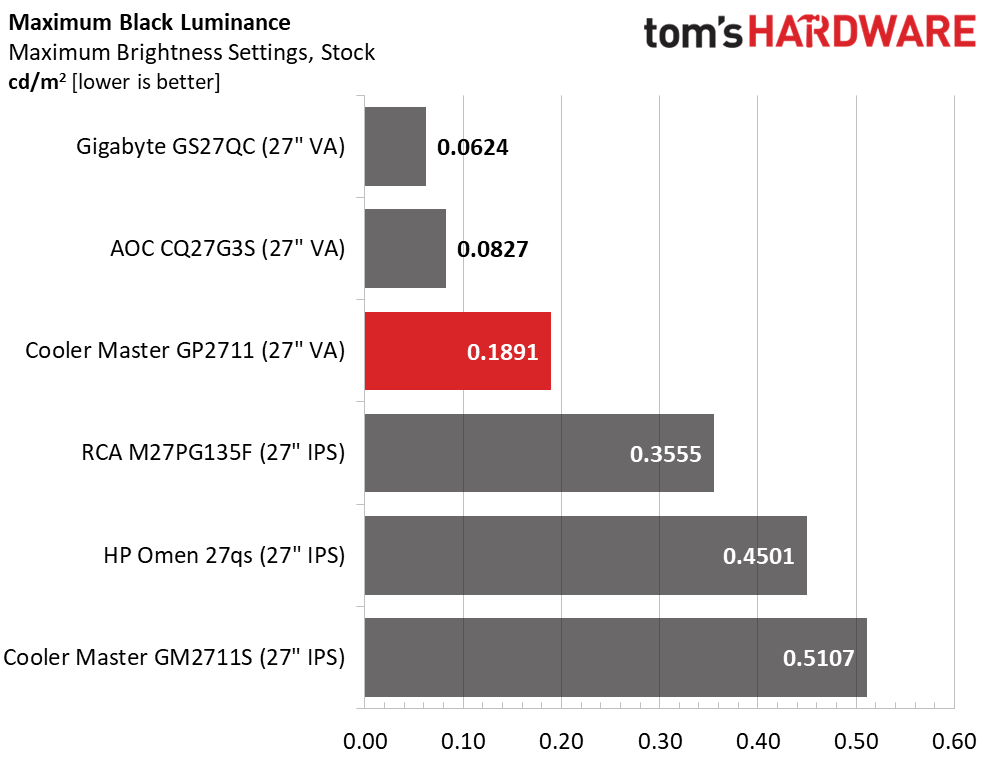
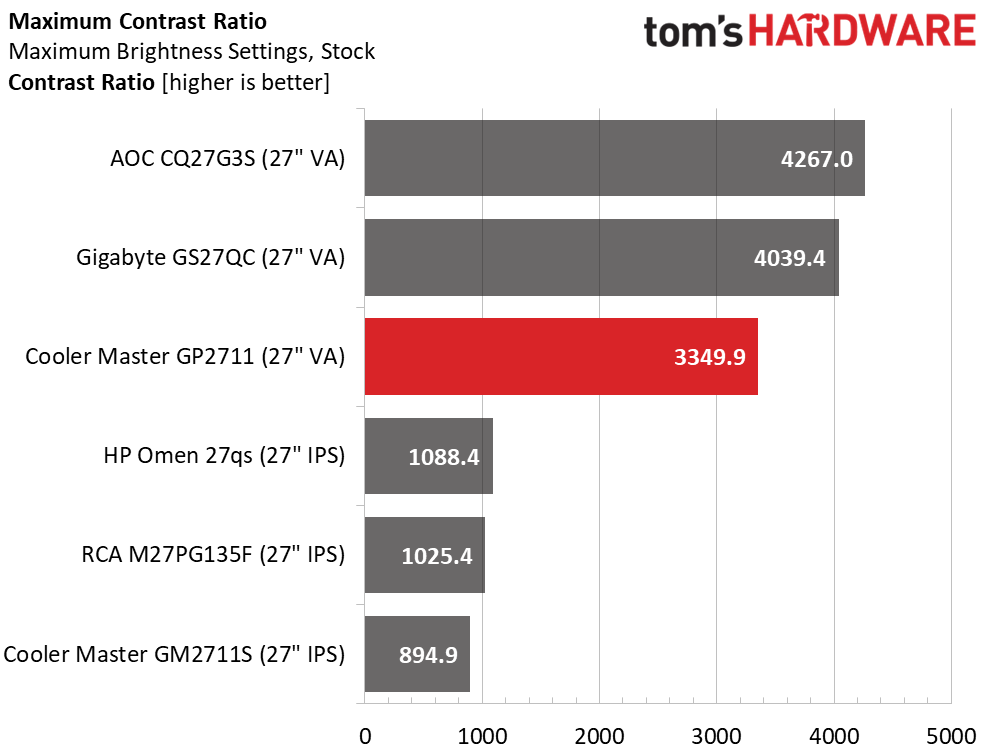
Regarding peak SDR brightness, the GP2711 gives users a choice. Max brightness is turned off by default, which limits the white level to 296 nits. That’s plenty of juice for any indoor environment. But if you want the full output, turn the option on for over 633 nits. The only drawback is the minimum level becomes 135 nits and the individual clicks of the brightness slider are very coarse, 5-6 nits each. That makes achieving a precise level more difficult.
In any case, black levels are consistently low, meaning contrast is over 3,300:1. That’s a bit above average for VA panels, though the AOC and Gigabyte boast over 4,000:1. The visual difference is small. The GP2711 delivers excellent native contrast with local dimming turned off.
After Calibration to 200 nits
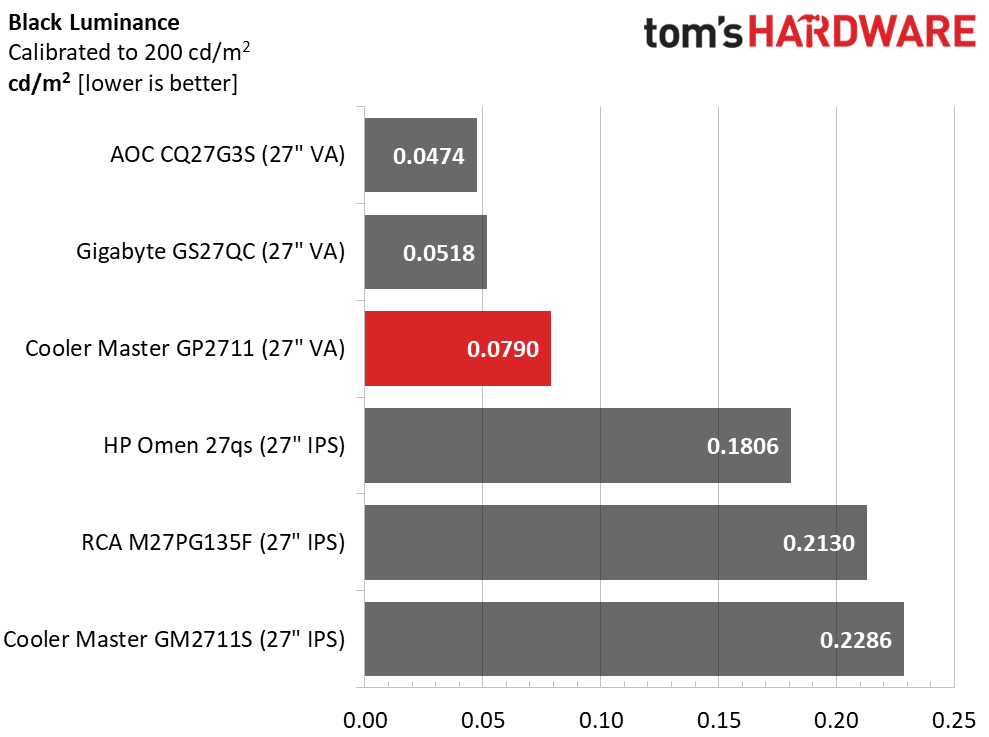
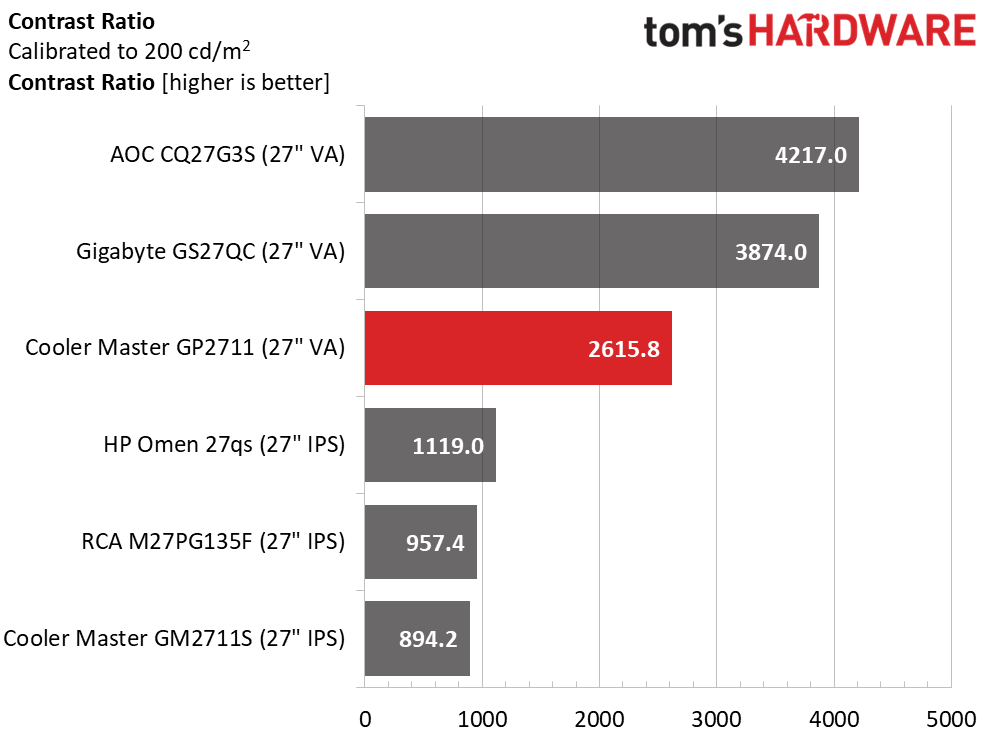
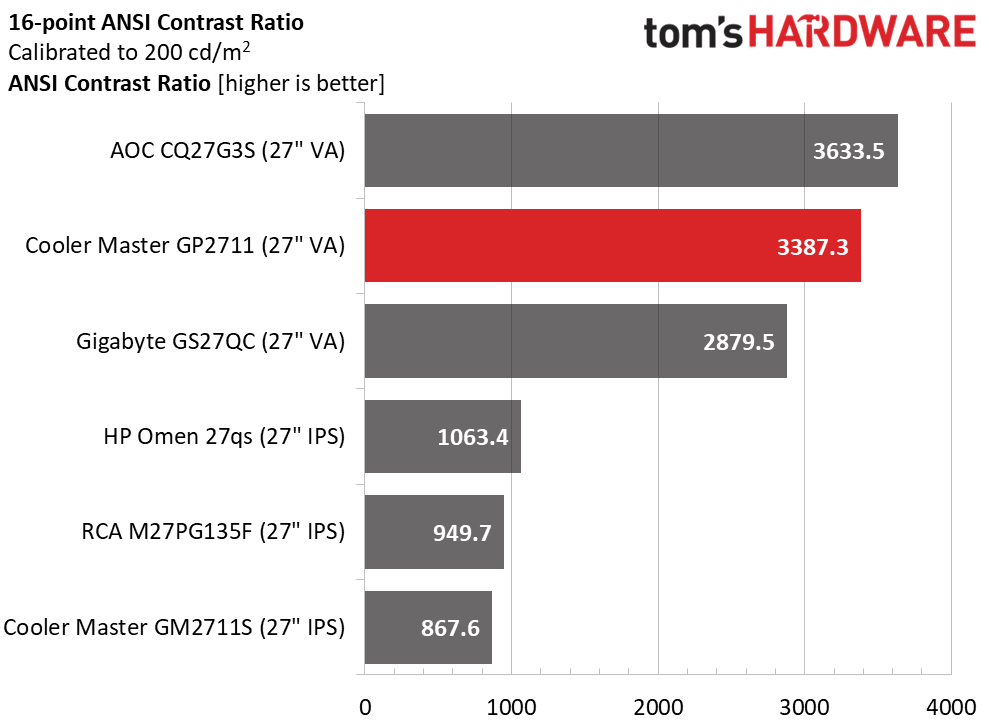
Calibration lost me some contrast; it’s now at 2615:1, not bad, but not great. I was initially surprised by this, but the reason became clear when I ran the ANSI test. It’s up at 3,387.3:1, which suggests that local dimming isn’t completely turned off. And that’s OK. I saw no clipping of detail, so, no downside.
Testing the local dimming settings for SDR showed that even at the lowest options, it is very aggressive. Contrast increased to around 6,000:1, but there was obvious clipping in both highlight and shadow areas. If you use local dimming for SDR, check it out with content. It’ll work fine in some cases and not so fine in others. Your mileage will vary.
Test Takeaway: The GP2711 has excellent native contrast and does not need its local dimming feature for SDR content. That’s the benefit of its VA panel, which gives it a clear advantage over IPS monitors. And if you need more than 300 nits of output, just turn Max Brightness on for over 633 nits. That’s really bright!
MORE: Best Gaming Monitors
Get Tom's Hardware's best news and in-depth reviews, straight to your inbox.
MORE: How We Test PC Monitors
MORE: How to Buy a PC Monitor
Current page: Brightness and Contrast
Prev Page Response, Input Lag, Viewing Angles and Uniformity Next Page Grayscale, Gamma and ColorThe GP2711 includes a calibration data sheet and is reasonably close out of the box. But I found calibration improved it visibly. I also noted that I could adjust separately for multiple color gamuts, which is something very few monitors can do; it's pretty nice for $449!
Christian Eberle is a Contributing Editor for Tom's Hardware US. He's a veteran reviewer of A/V equipment, specializing in monitors. Christian began his obsession with tech when he built his first PC in 1991, a 286 running DOS 3.0 at a blazing 12MHz. In 2006, he undertook training from the Imaging Science Foundation in video calibration and testing and thus started a passion for precise imaging that persists to this day. He is also a professional musician with a degree from the New England Conservatory as a classical bassoonist which he used to good effect as a performer with the West Point Army Band from 1987 to 2013. He enjoys watching movies and listening to high-end audio in his custom-built home theater and can be seen riding trails near his home on a race-ready ICE VTX recumbent trike. Christian enjoys the endless summer in Florida where he lives with his wife and Chihuahua and plays with orchestras around the state.
-
cknobman Forgive my ignorance but if local dimming ruins the picture what is the point, or advantage, of having the mini led's and over 500 dimming zones? (besides a brighter picture)Reply -
UnforcedERROR Reply
Fascinating question, because otherwise you're dealing with a completely standard LCD experience. The entire point of dimming zones is to give better contrast, especially when it comes to black levels. I read another review contrary to this, which also noted the brightness being diminished, that claimed local dimming was helpful with image quality.cknobman said:Forgive my ignorance but if local dimming ruins the picture what is the point, or advantage, of having the mini led's and over 500 dimming zones? (besides a brighter picture)
I find it strange to say not to use local dimming in a mini-LED monitor, personally. -
crimsonfilms I have theReply
I have the GP27U, the 4K version of this monitor. I love it. The dimming on that is excellent. As good as you gonna get for zone dimming panels. Mini LEDs still generally provide better brightness and to some extent color control than classic edge lit LEDs.cknobman said:Forgive my ignorance but if local dimming ruins the picture what is the point, or advantage, of having the mini led's and over 500 dimming zones? (besides a brighter picture) -
wingfinger I have sort of eliminated VA panels from my consideration. I have heard that there is a common issue with black smearing, caused by black parts of the image transitioning slower than the brighter parts.Reply
Most of the time I would value an artifact free image that is self-consistent. (I have heard that a few have ok-good transitions times, though)
For that reason, I also consider HDR, a nice to have because unless you have the budget for an OLED, there are times when you will want to turn it off. Right?
Games these days do seem to show no hesitation in having dark areas, though.
A lot of monitors are starting to sport a wide gamut. I would like to, also, use the monitor for some image editing or maybe content creation, but that would be SRGB or maybe Adobe. Right?
...
To be viable, the monitor has to support modes that correctly project the user input to the panels value set. Some don't have options, and some might not be accurate. Furthermore, the scaling would be crunching the numbers down -- more so the wider the native gamut. This for example, says a native 8 bit panel. A 10 bit panel could be better in this regard but might cost a bit more. -
UnforcedERROR Reply
The other version of this monitor is an IPS, and probably tracks closer to your expectation.wingfinger said:I have sort of eliminated VA panels from my consideration. I have heard that there is a common issue with black smearing, caused by black parts of the image transitioning slower than the brighter parts.
Most of the time I would value an artifact free image that is self-consistent. (I have heard that a few have ok-good transitions times, though)
For that reason, I also consider HDR, a nice to have because unless you have the budget for an OLED, there are times when you will want to turn it off. Right?
Games these days do seem to show no hesitation in having dark areas, though.
A lot of monitors are starting to sport a wide gamut. I would like to, also, use the monitor for some image editing or maybe content creation, but that would be SRGB or maybe Adobe. Right?
...
To be viable, the monitor has to support modes that correctly project the user input to the panels value set. Some don't have options, and some might not be accurate. Furthermore, the scaling would be crunching the numbers down -- more so the wider the native gamut. This for example, says a native 8 bit panel. A 10 bit panel could be better in this regard but might cost a bit more.
That said, it's rare to find a true 10-bit panel in this price range. Most things listed as 10-bit are really 8-bit + FRC. The difference is negligible, but some people are picky about that. -
-Fran- The CM miniLEDs are like the dark horse of the race. They are super good.Reply
I got one of them last Xmas because they were super cheap and the specs were super good. After receiving the first one, I bought 3 more, but unfortunately they only had 2 left, so I was only able to get 3 in total.
In any case, it's a really good monitor for the price. More so if you can find it with a nice discount.
Regards. -
wingfinger When I was looking at rtings a while back, I saw AOC Q27G3XMN had some similar qualities.Reply
But I felt it was a risk. It shows up as a notable mention for best gaming monitors list despite overall good scores. -
35below0 "The GP2711’s VA panel already provides a lot of dynamic range. It doesn’t need much help to be excellent."Reply
I guess the dimming doesn't add so much to this monitor, but that is hardly dissapointing.
Might be a useful setting to tweak. For someone. -
digitalgriffin There's a lack of understanding here by many.Reply
FIrst off, cooler master doesn't make their own panels. They pick one from a few mfgs like AU Optronix, Samsung, or LG. There's a few other players but they are the big ones.
Local dimming zones not only increase contrast but can also help with color accuracy. Let me explain.
Every LCD panel has back light bleed. That's the small percentage of light that shoots through even when the LCD cell is full closed. So let's take some really exaggerated numbers. For example let's say we have a 10% leak through. Let's say you wanted 50% red. Are you looking at 54% red, 10% Blue 10% green. That's because of wash through and black level minimums and calibration. You aren't looking at a true red but a semi washed out version.
To understand this look at the stars from a city. Most are washed out against a backlit sky from city lights. Now go to the country and look. Way different view..
So let's say we want to improve this. We turn down the backlight by half. You open red fully at 100% instead of 50% because we have 1/2 light. But the back light bleed through is half. This is where the improvement comes from.
The other issue is led light purity. Ideally to get a full color gamut you not only require low black levels, but also pure light colors. Red, Green, and Blue LEDs aren't truly mono chromatic like a laser. They give off a color distribution around their pure color. But again this creates color impurities. The only way to fix this is color filters. This is where tech like quantum dots come in. They really narrow the spectrum of light output. But quantum dots (QD) have longevity issues as they are typically organic, suffer burn in, and lamination issues. The failure rate of early QDs is huge.
Those 10 bit panels are a bit misleading also. There very few fast high quality true 10 bit panels and they cost a fortune. What most cheap 10 bit panels take an 8 bit panels and then alternate how often the panel blips open. I'm going to simplify some math here and say our panel is only capable of 200 distinct levels (8 bit is 256 but...math is complicated) Let's say you want 25.1% red. What you would get is a 50 one frame, 50 another frame, 50 a third frame, and then 51 the fourth. What's 201/(200 * 4 frames). ? That's right 25,1. However you werent looking at 25.1% every frame. Your eyes averaged it out. It's a cheap trick that has limitations. And this is a very common trick for really fast cheap TN panels, which use even worse 6 bit panels!
Finally the last issue is your environment. Unless you play in a dark dark room you won't benefit from most of this tech because your own screen reflects light impurities back into your eye. You ever look through a car window and see your own face reflected back? Your room is full of light polluting sources reflected by that screen.
And ignore that article about ratings.com about oleds being superior. Burn in on regular LED LCD is near impossible and easily reversible. What you do get is burn in of QD elements. Or you get liquid crystal memory. The later is fixable by quickly switching from closed to open for an hour or so.
For content masters you need to look at your target output. If it's film/TV, rec 2020. For all other consider DCI P3 or at the very least 100% sRGB coverage. -
razor512 Reply
There is one benefit to having a display like that and just setting it to a single static uniform backlight, while the luminance range gets decreased for HDR content (would effectively become HDR600 ), if the wider color gamut is maintained, then with good calibration, HDR gaming displays can work decently for video and photo work.cknobman said:Forgive my ignorance but if local dimming ruins the picture what is the point, or advantage, of having the mini led's and over 500 dimming zones? (besides a brighter picture)
